

Accessory Apartments
Reviewed
Learn how accessory apartments offer flexible housing, added income, and independent living in spaces like basements, attics, or garages.

Heating System Maintenance
Reviewed
Learn how to maintain your home's heating system for efficiency, safety, and comfort with practical tips on furnaces, ducts, and radiators.
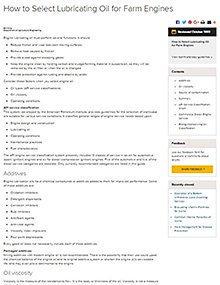
How to Select Lubricating Oil for Farm Engines
Reviewed
Essential information on selecting the appropriate engine oil for farm equipment, covering oil types, viscosity, additives, and operating conditions.
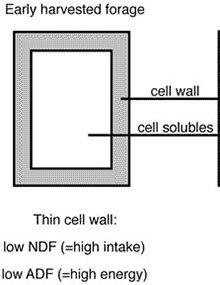
Using NDF and ADF to Balance Diets
Reviewed
Estimate forage intake and energy values for cattle diets using NDF and ADF measurements to optimize animal performance and feed efficiency.
Whole Soybeans for Dairy Cattle
Reviewed
Whole soybeans offer high energy and palatability for dairy cows but must be fed in moderation to avoid excess dietary fat affecting milk production.
Displaced Abomasum
Reviewed
The abomasum is the fourth, or "true," stomach in the cow. It normally lies low down in the right front quadrant of the abdomen, just inside the seventh through 11th ribs (Figure 1). Adjacent to the abomasum, on the left side of the abdomen, is the large first stomach, or rumen (Figure 2).

Recommendations for Aging Beef
Reviewed
The main reason for aging beef is to improve the tenderness and the flavor of the meat. Visit our site for recommendations for aging beef.

Birdsfoot Trefoil
Reviewed
Birdsfoot trefoil is a long-lived perennial legume ideal for Missouri pastures, offering summer forage, bloat-free grazing, and higher livestock gains.
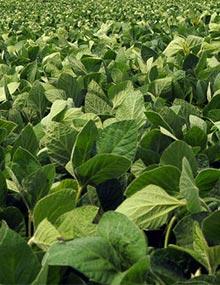
Soybean Production in Missouri
Reviewed
Soybeans were the most successful crop for Missouri farmers in the 1970s & 1980s. Visit our site to learn more about Soybean Production in Missouri.

Is Your Wiring System Safe and Energy Efficient?
Reviewed
Learn how to assess and improve your home's electrical wiring for safety and energy efficiency, including tips on circuit protection and common warning signs.

Feeding and Housing Dairy Goats
Reviewed
Sound feeding and housing practices result in optimum goat growth and goat milk production. Visit our site to learn about Feeding and Housing Dairy Goats.

Reed Canarygrass, Ryegrass, and Garrison Creeping Foxtail
Reviewed
Reed canarygrassReed canarygrass is a tall-growing, cool season perennial with a rhizomatous root system (it roots by sending out runners).

Irrigating Soybeans
Reviewed
Irrigation boosts soybean yields on drought-prone Missouri soils, with short-season varieties showing the greatest response during peak water demand periods.
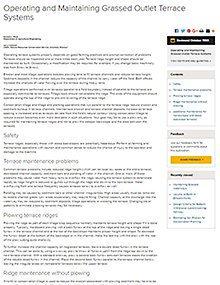
Operating and Maintaining Grassed Outlet Terrace Systems
Reviewed
Discover best practices for maintaining grassed outlet terraces, focusing on ridge preservation, sediment control, and erosion mitigation.
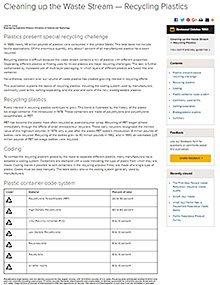
Cleaning up the Waste Stream — Recycling Plastics
Reviewed
Recycling plastics is challenging due to mixed materials and multi-layer packaging. Guide explains plastic codes, sorting methods, and biodegradable options.

Design Criteria for Canopy and Hood Inlet Spillways
Reviewed
These criteria apply to the design of canopy and hood inlet spillways used as the principal spillway for ponds, irrigation reservoirs, and stabilization structures.
The canopy or hood inlet spillway usually is used in conjunction with an emergency spillway.

Design Criteria for Debris Basins
Reviewed
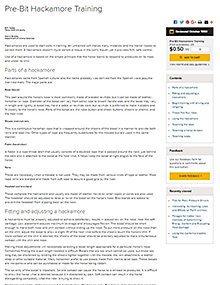
Pre-Bit Hackamore Training
Reviewed
Learn how to properly fit and adjust a hackamore to safely train young horses, ensuring effective communication without injuring sensitive mouth tissue.
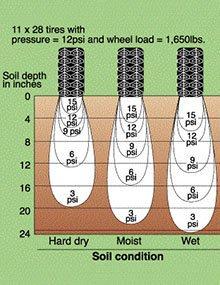
Soil Compaction: The Silent Thief
Reviewed

Portable Ladder Safety
Reviewed
Essential safety tips for using portable ladders, including proper selection, maintenance, and hazard prevention, to reduce the risk of falls and injuries.

Preparing for an Emergency: Home Heating in an Emergency
Reviewed
At some time you may face a heating emergency. Visit our site for our Preparing for an Emergency: Home Heating in an Emergency guide.
Backgrounding Calves Part 1: Assessing the Opportunity
Reviewed
Backgrounding is the growing of steers & heifers from weaning until they enter the feedlot. Visit our site to learn more about backgrouding calves.

Cotton Insects and Mites
Reviewed
Editor's note

Kitchens for Workers in Wheelchairs
Reviewed
Design kitchens for wheelchair users with ample space, accessible storage, and adjustable counters to improve comfort and usability.

How to Build a Compost Bin
Reviewed
Learn to build compost bins using wire mesh or snow fencing. Includes materials, tools, and step-by-step instructions for effective composting.